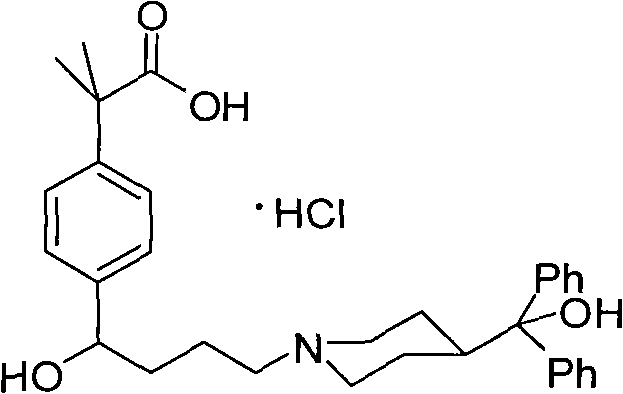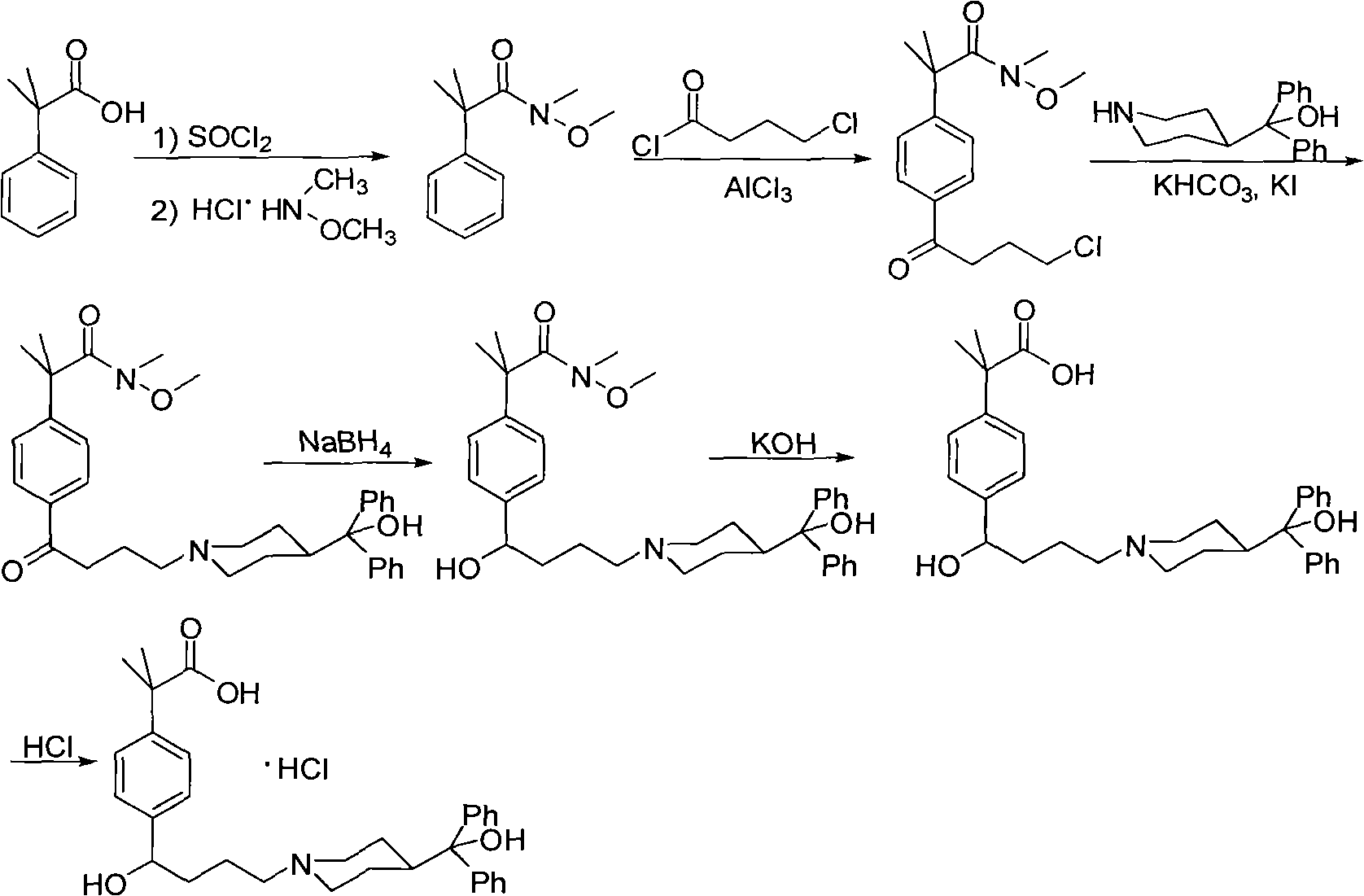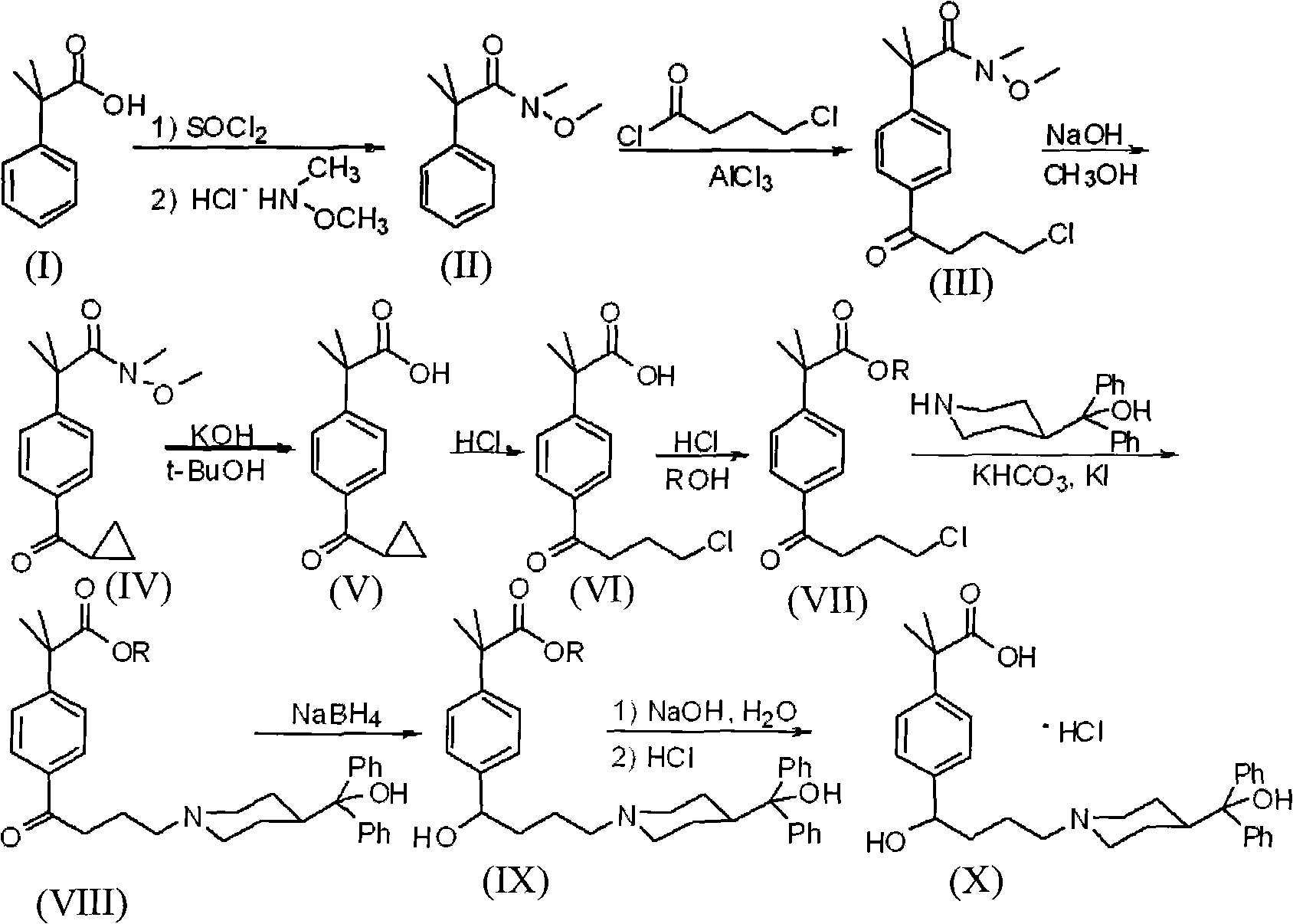Synthetic method of a fexofenadine hydrochloride
A fexofenadine and synthetic method technology, applied in the direction of active ingredients of heterocyclic compounds, drug combination, organic chemistry, etc., can solve the problem of reducing purity and yield, difficult separation of amides, and production of fexofenadine hydrochloride Cost increase and other issues, to achieve the effect of low pollution and high yield
- Summary
- Abstract
- Description
- Claims
- Application Information
AI Technical Summary
Problems solved by technology
Method used
Image
Examples
Embodiment 1
[0042] The present invention starts with N-methyl-N-methoxy-2-[4-(4-chlorobutyryl)phenyl]-2-methylpropanamide (III) as the starting material. The synthetic method of N-methyl-N-methoxyl-2-[4-(4-chlorobutyryl) phenyl]-2-methylpropionamide is prepared by prior art: (1) 98.4 grams (0.6 mol) α, α-dimethylphenylacetic acid was dissolved in 400 milliliters of toluene, 131 milliliters of thionyl chloride was added dropwise at 0°C, stirred at room temperature for 15 hours and then refluxed for 2 hours, and 100 Milliliters of toluene and excess thionyl chloride, add 184.6 grams (1.34mol) of potassium carbonate, 58.5 grams (0.6mol) of N, O-dimethylhydroxylamine hydrochloride and 300 milliliters of water, stir and react at room temperature for 4 hours, and the reaction is complete Afterwards, 200 ml of 2N hydrochloric acid was added dropwise to the reaction mixture, and the liquids were separated. The organic phase was washed with 2N hydrochloric acid, saturated sodium bicarbonate, and s...
Embodiment 2
[0053] Using the N-methyl-N-methoxy-2-[4-(4-chlorobutyryl)phenyl]-2-methylpropanamide prepared by the method of the above-mentioned Example 1 as the starting material, in 250 ml three Add 20.50 grams (82%, 0.30mol) potassium hydroxide and 150 milliliters of anhydrous methanol in the flask and stir evenly, then, 15.50 grams (0.05mol) N-methyl-N-methoxy-2-[ 4-(4-Chlorobutyryl)phenyl]-2-methylpropanamide was dissolved in 50 ml of anhydrous methanol to form a uniformly stirred solution, which was added dropwise to the three-necked flask. After the dropwise addition was completed, the reaction was stirred at 20°C 30 hours. After the reaction was completed, anhydrous methanol was distilled off under reduced pressure, 100 ml of water and 100 ml of dichloromethane were added to the residue, the layers were separated, and the aqueous layer was extracted twice with 100 ml of dichloromethane respectively. The extracts containing the dichloromethane layer were combined, dried with anhydr...
Embodiment 3
[0059] Using the N-methyl-N-methoxy-2-[4-(4-chlorobutyryl)phenyl]-2-methylpropanamide prepared by the method of the above-mentioned Example 1 as the starting material, in 250 ml three Add 20.00 grams (0.50mol) of sodium hydroxide and 150 milliliters of absolute ethanol in the flask, stir evenly, then, while stirring, 15.50 grams (0.05mol) of N-methyl-N-methoxy-2-[4- (4-Chlorobutyryl)phenyl]-2-methylpropanamide is dissolved in 50 ml of absolute ethanol to form a uniformly stirred solution, which is added dropwise to a three-necked flask. After the dropwise addition, stir and react at 50°C for 30 hours . After the reaction was completed, absolute ethanol was distilled off under reduced pressure, 100 ml of water and 100 ml of dichloromethane were added to the residue, the layers were separated, and the aqueous layer was extracted twice with 100 ml of dichloromethane respectively. Combine the extracts containing the dichloromethane layer, dry over anhydrous sodium sulfate, filter...
PUM
 Login to View More
Login to View More Abstract
Description
Claims
Application Information
 Login to View More
Login to View More - R&D
- Intellectual Property
- Life Sciences
- Materials
- Tech Scout
- Unparalleled Data Quality
- Higher Quality Content
- 60% Fewer Hallucinations
Browse by: Latest US Patents, China's latest patents, Technical Efficacy Thesaurus, Application Domain, Technology Topic, Popular Technical Reports.
© 2025 PatSnap. All rights reserved.Legal|Privacy policy|Modern Slavery Act Transparency Statement|Sitemap|About US| Contact US: help@patsnap.com



